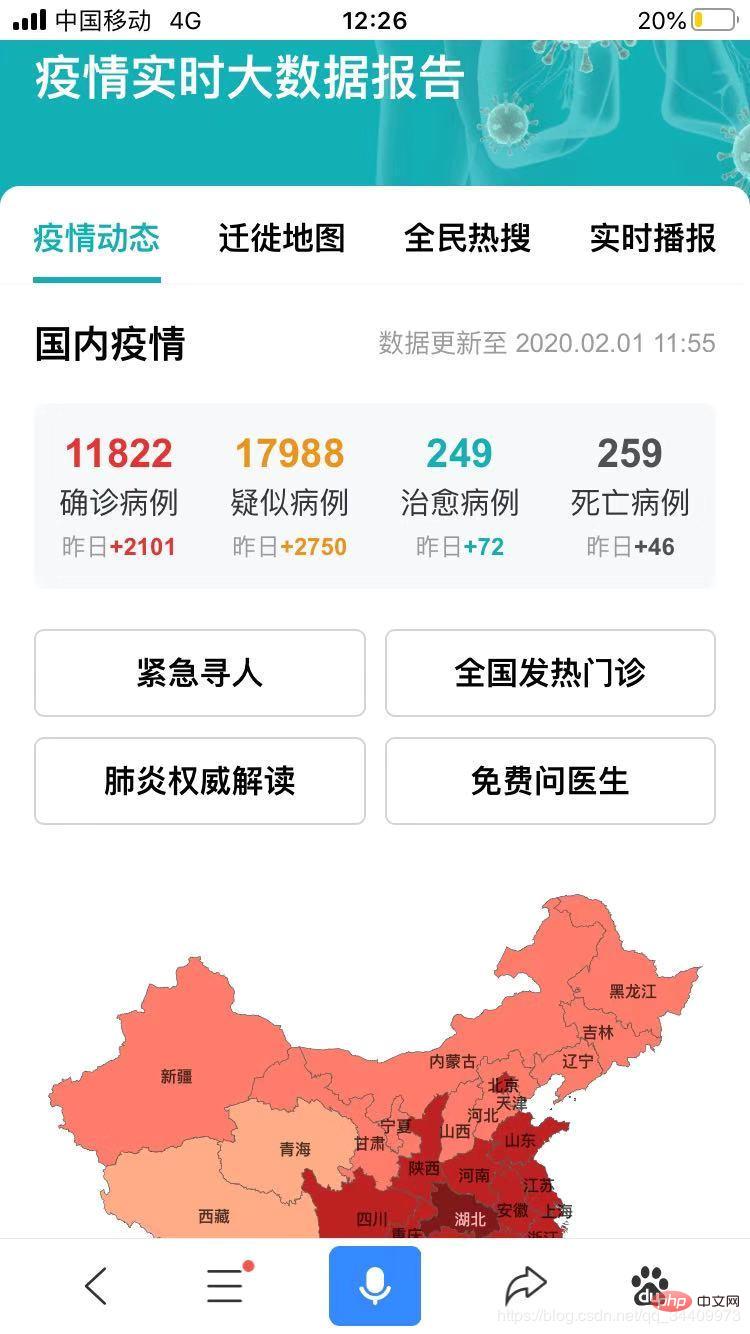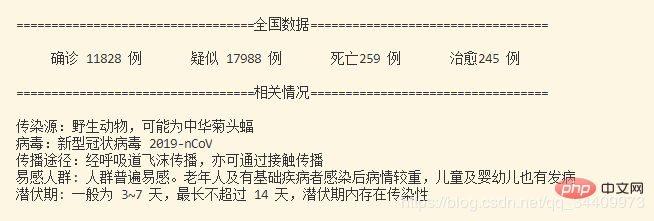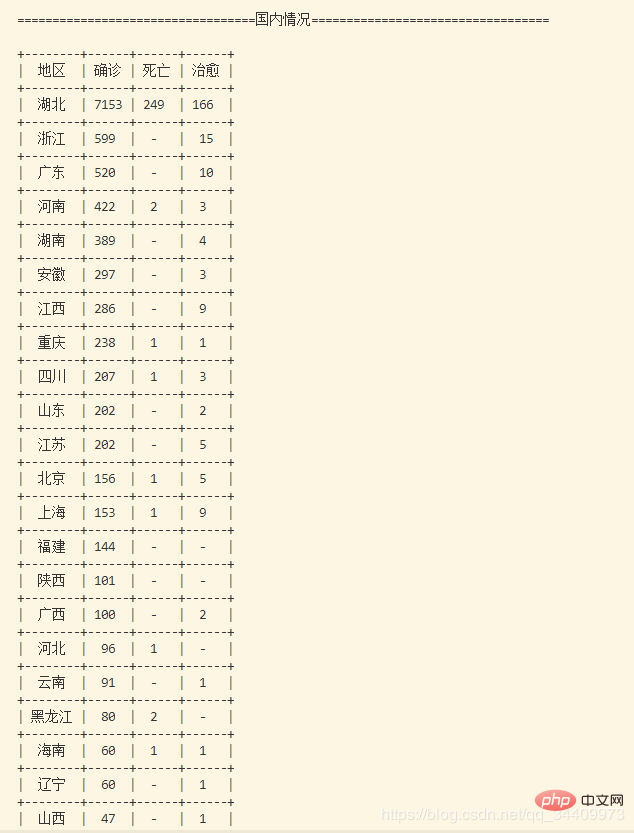Python real-time data collection-novel coronavirus

Python real-time data collection-new coronavirus
Source code source : https://github.com/Programming-With-Love/2019-nCoV
The epidemic data time is: 2020.2.1

Related screenshots of the project:
National Data Display

National Data Display

Foreign data display

View detailed data of the specified area

##Source code, pay attention to installing the required modules (such as pip install module name)
import requests
import re
from bs4 import BeautifulSoup
from time import sleep
import json
from prettytable import ALL
from prettytable import PrettyTable
hubei = {}
guangdong = {}
zhejiang = {}
beijing = {}
shanghai = {}
hunan = {}
anhui = {}
chongqing = {}
sichuan = {}
shandong = {}
guangxi = {}
fujian = {}
jiangsu = {}
henan = {}
hainan = {}
tianjin = {}
jiangxi = {}
shanxi1 = {} # 陕西
guizhou = {}
liaoning = {}
xianggang = {}
heilongjiang = {}
aomen = {}
xinjiang = {}
gansu = {}
yunnan = {}
taiwan = {}
shanxi2 = {} # 山西
jilin = {}
hebei = {}
ningxia = {}
neimenggu = {}
qinghai = {} # none
xizang = {} # none
provinces_idx = [hubei, guangdong, zhejiang, chongqing, hunan, anhui, beijing,
shanghai, henan, guangxi, shandong, jiangxi, jiangsu, sichuan,
liaoning, fujian, heilongjiang, hainan, tianjin, hebei, shanxi2,
yunnan, xianggang, shanxi1, guizhou, jilin, gansu, taiwan,
xinjiang, ningxia, aomen, neimenggu, qinghai, xizang]
map = {
'湖北':0, '广东':1, '浙江':2, '北京':3, '上海':4, '湖南':5, '安徽':6, '重庆':7,
'四川':8, '山东':9, '广西':10, '福建':11, '江苏':12, '河南':13, '海南':14,
'天津':15, '江西':16, '陕西':17, '贵州':18, '辽宁':19, '香港':20, '黑龙江':21,
'澳门':22, '新疆':23, '甘肃':24, '云南':25, '台湾':26, '山西':27, '吉林':28,
'河北':29, '宁夏':30, '内蒙古':31, '青海':32, '西藏':33
}
def getTime(text):
TitleTime = str(text)
TitleTime = re.findall('<span>(.*?)</span>', TitleTime)
return TitleTime[0]
def getAllCountry(text):
AllCountry = str(text)
AllCountry = AllCountry.replace("[<p class=\"confirmedNumber___3WrF5\"><span class=\"content___2hIPS\">", "")
AllCountry = AllCountry.replace("<span style=\"color: #4169e2\">", "")
AllCountry = re.sub("</span>", "", AllCountry)
AllCountry = AllCountry.replace("</p>]", "")
AllCountry = AllCountry.replace("<span style=\"color: rgb(65, 105, 226);\">", "")
AllCountry = re.sub("<span>", "", AllCountry)
AllCountry = re.sub("<p>", "", AllCountry)
AllCountry = re.sub("</p>", "", AllCountry)
return AllCountry
def query(province):
table = PrettyTable(['地区', '确诊', '死亡', '治愈'])
for (k, v) in province.items():
name = k
table.add_row([name, v[0] if v[0] != 0 else '-', v[1] if v[1] != 0 else '-', v[2] if v[2] != 0 else '-'])
if len(province.keys()) != 0:
print(table)
else:
print("暂无")
def getInfo(text):
text = str(text)
text = re.sub("<p class=\"descText___Ui3tV\">", "", text)
text = re.sub("</p>", "", text)
return text
def is_json(json_str):
try:
json.loads(json_str)
except ValueError:
return False
return True
def ff(str, num):
return str[:num] + str[num+1:]
def main():
url = "https://3g.dxy.cn/newh5/view/pneumonia"
try:
headers = {}
headers['user-agent'] = 'Mozilla/5.0 (Windows NT 10.0; Win64; x64) AppleWebKit/537.36 (KHTML, like Gecko) Chrome/70.0.3538.77 Safari/537.36' #http头大小写不敏感
headers['accept'] = 'text/html,application/xhtml+xml,application/xml;q=0.9,image/webp,image/apng,*/*;q=0.8'
headers['Connection'] = 'keep-alive'
headers['Upgrade-Insecure-Requests'] = '1'
r = requests.get(url, headers=headers)
r.raise_for_status()
r.encoding = r.apparent_encoding
soup = BeautifulSoup(r.text,'lxml')
table = PrettyTable(['地区', '确诊', '死亡', '治愈'])
table.hrules = ALL
#### 截至时间
# TitleTime = getTime(soup.select('.title___2d1_B'))
print()
# print(" ",TitleTime + "\n")
while True:
r = requests.get("https://service-f9fjwngp-1252021671.bj.apigw.tencentcs.com/release/pneumonia")
json_str = json.loads(r.text)
if json_str['error'] == 0:
break
print("==================================全国数据==================================")
print()
print(" 确诊 " + str(json_str['data']['statistics']['confirmedCount']) + " 例"
+ " " + "疑似 " + str(json_str['data']['statistics']['suspectedCount']) + " 例"
+ " " + "死亡" + str(json_str['data']['statistics']['deadCount']) + " 例"
+ " " + "治愈" + str(json_str['data']['statistics']['curedCount']) + " 例\n")
print("==================================相关情况==================================")
print()
print("传染源:" + json_str['data']['statistics']['infectSource'])
print("病毒:" + json_str['data']['statistics']['virus'])
print("传播途径:" + json_str['data']['statistics']['passWay'])
print(json_str['data']['statistics']['remark1'])
print(json_str['data']['statistics']['remark2'] + "\n")
print("==================================国内情况==================================")
print()
json_provinces = re.findall("{\"provinceName\":(.*?)]}", str(soup))
idx = 0
for province in json_provinces:
if is_json(province):
pass
else:
province = "{\"provinceName\":" + province + "]}"
province = json.loads(province)
province_name = province['provinceShortName'] if province['provinceShortName'] != 0 else '-'
confirmed = province['confirmedCount'] if province['confirmedCount'] != 0 else '-'
suspected = province['suspectedCount'] if province['suspectedCount'] != 0 else '-'
cured = province['curedCount'] if province['curedCount'] != 0 else '-'
dead = province['deadCount'] if province['deadCount'] != 0 else '-'
table.add_row([province_name, confirmed, dead, cured])
map[province_name] = idx
idx = idx + 1
for city in province['cities']:
provinces_idx[map[province_name]][city['cityName']] = [city['confirmedCount'], city['deadCount'], city['curedCount']]
print(table)
print()
print("==================================国外情况==================================")
print()
json_provinces = str(re.findall("\"id\":949(.*?)]}", str(soup)))
json_provinces = json_provinces[:1] + "{\"id\":949" + json_provinces[2:]
json_provinces = json_provinces[:len(json_provinces) - 2] + json_provinces[len(json_provinces) - 1:]
provinces = json.loads(json_provinces)
table = PrettyTable(['地区', '确诊', '死亡', '治愈'])
for province in provinces:
confirmed = province['confirmedCount'] if province['confirmedCount'] != 0 else '-'
dead = province['deadCount'] if province['deadCount'] != 0 else '-'
cured = province['curedCount'] if province['curedCount'] != 0 else '-'
table.add_row([province['provinceName'], confirmed, dead, cured])
print(table)
print()
print("==================================最新消息==================================")
print()
idx = 0
for news in json_str['data']['timeline']:
if idx == 5:
break
print(news['pubDateStr'] + " " + news['title'])
idx = idx + 1
print()
key = input("请输入您想查询详细信息的省份,例如 湖北\n")
print()
if key in map.keys():
query(provinces_idx[map[key]])
else:
print("暂无相关信息")
print("\n欢迎提出各种意见")
except:
print("连接失败")
if __name__ == '__main__':
main()
sleep(30)Finally, I wish everyone is immune to all kinds of poisons. Come on, China! ! We will definitely get through this! !
The above is the detailed content of Python real-time data collection-novel coronavirus. For more information, please follow other related articles on the PHP Chinese website!

Hot AI Tools

Undresser.AI Undress
AI-powered app for creating realistic nude photos

AI Clothes Remover
Online AI tool for removing clothes from photos.

Undress AI Tool
Undress images for free

Clothoff.io
AI clothes remover

Video Face Swap
Swap faces in any video effortlessly with our completely free AI face swap tool!

Hot Article

Hot Tools

Notepad++7.3.1
Easy-to-use and free code editor

SublimeText3 Chinese version
Chinese version, very easy to use

Zend Studio 13.0.1
Powerful PHP integrated development environment

Dreamweaver CS6
Visual web development tools

SublimeText3 Mac version
God-level code editing software (SublimeText3)

Hot Topics
 1389
1389
 52
52
 Choosing Between PHP and Python: A Guide
Apr 18, 2025 am 12:24 AM
Choosing Between PHP and Python: A Guide
Apr 18, 2025 am 12:24 AM
PHP is suitable for web development and rapid prototyping, and Python is suitable for data science and machine learning. 1.PHP is used for dynamic web development, with simple syntax and suitable for rapid development. 2. Python has concise syntax, is suitable for multiple fields, and has a strong library ecosystem.
 PHP and Python: Different Paradigms Explained
Apr 18, 2025 am 12:26 AM
PHP and Python: Different Paradigms Explained
Apr 18, 2025 am 12:26 AM
PHP is mainly procedural programming, but also supports object-oriented programming (OOP); Python supports a variety of paradigms, including OOP, functional and procedural programming. PHP is suitable for web development, and Python is suitable for a variety of applications such as data analysis and machine learning.
 Can vs code run in Windows 8
Apr 15, 2025 pm 07:24 PM
Can vs code run in Windows 8
Apr 15, 2025 pm 07:24 PM
VS Code can run on Windows 8, but the experience may not be great. First make sure the system has been updated to the latest patch, then download the VS Code installation package that matches the system architecture and install it as prompted. After installation, be aware that some extensions may be incompatible with Windows 8 and need to look for alternative extensions or use newer Windows systems in a virtual machine. Install the necessary extensions to check whether they work properly. Although VS Code is feasible on Windows 8, it is recommended to upgrade to a newer Windows system for a better development experience and security.
 Is the vscode extension malicious?
Apr 15, 2025 pm 07:57 PM
Is the vscode extension malicious?
Apr 15, 2025 pm 07:57 PM
VS Code extensions pose malicious risks, such as hiding malicious code, exploiting vulnerabilities, and masturbating as legitimate extensions. Methods to identify malicious extensions include: checking publishers, reading comments, checking code, and installing with caution. Security measures also include: security awareness, good habits, regular updates and antivirus software.
 How to run programs in terminal vscode
Apr 15, 2025 pm 06:42 PM
How to run programs in terminal vscode
Apr 15, 2025 pm 06:42 PM
In VS Code, you can run the program in the terminal through the following steps: Prepare the code and open the integrated terminal to ensure that the code directory is consistent with the terminal working directory. Select the run command according to the programming language (such as Python's python your_file_name.py) to check whether it runs successfully and resolve errors. Use the debugger to improve debugging efficiency.
 Can visual studio code be used in python
Apr 15, 2025 pm 08:18 PM
Can visual studio code be used in python
Apr 15, 2025 pm 08:18 PM
VS Code can be used to write Python and provides many features that make it an ideal tool for developing Python applications. It allows users to: install Python extensions to get functions such as code completion, syntax highlighting, and debugging. Use the debugger to track code step by step, find and fix errors. Integrate Git for version control. Use code formatting tools to maintain code consistency. Use the Linting tool to spot potential problems ahead of time.
 Can vscode be used for mac
Apr 15, 2025 pm 07:36 PM
Can vscode be used for mac
Apr 15, 2025 pm 07:36 PM
VS Code is available on Mac. It has powerful extensions, Git integration, terminal and debugger, and also offers a wealth of setup options. However, for particularly large projects or highly professional development, VS Code may have performance or functional limitations.
 Can vscode run ipynb
Apr 15, 2025 pm 07:30 PM
Can vscode run ipynb
Apr 15, 2025 pm 07:30 PM
The key to running Jupyter Notebook in VS Code is to ensure that the Python environment is properly configured, understand that the code execution order is consistent with the cell order, and be aware of large files or external libraries that may affect performance. The code completion and debugging functions provided by VS Code can greatly improve coding efficiency and reduce errors.




